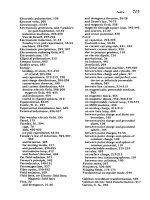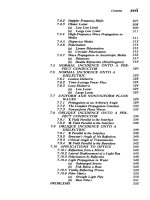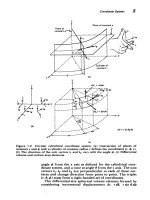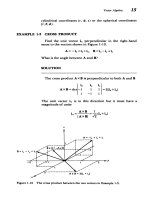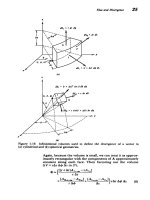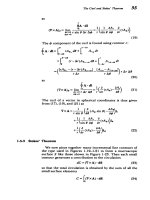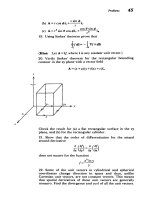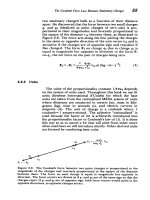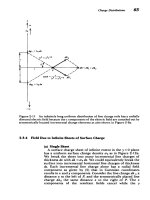Electromagnetic Field Theory: A Problem Solving Approach Part 4 potx
Bạn đang xem bản rút gọn của tài liệu. Xem và tải ngay bản đầy đủ của tài liệu tại đây (251.43 KB, 10 trang )
Coordinate
Systems
5
(b)
V=
rdr
dodz
(c)
Figure
1-2
Circular
cylindrical
coordinate
system.
(a)
Intersection
of
planes
of
constant
z
and
4
with
a
cylinder
of constant radius
r
defines
the coordinates
(r,
4,
z).
(b)
The
direction
of
the unit
vectors
i,
and
i,
vary
with
the
angle
46.
(c)
Differential
volume
and
surface
area
elements.
angle
4
from the
x
axis
as
defined
for
the
cylindrical
coor-
dinate
system,
and
a
cone at angle
0
from
the
z
axis.
The
unit
vectors
i,,
is
and
i#
are
perpendicular
to
each
of
these
sur-
faces
and
change
direction from
point
to
point.
The
triplet
(r,
0,
4)
must
form
a
right-handed
set
of
coordinates.
The
differential-size
spherical
volume
element
formed
by
considering
incremental
displacements
dr,
r
dO,
r
sin
0
d4
6
Review
of
Vector
Analysis
=
r
sin
dr
do
Al
Figure
1-3
Spherical
coordinate
system.
(a) Intersection
of
plane
of constant
angle
0
with
cone
of constant
angle
0
and
sphere
of constant
radius
r
defines
the
coordinates
(r,
0,
4).
(b)
Differential volume
and
surface
area
elements.
i
I· · · ·
I·
ll•U
V
I•
Vector
Algebra
7
Table
1-2
Geometric
relations
between
coordinates
and
unit
vectors
for
Cartesian,
cylindrical,
and
spherical
coordinate
systems*
FESIAN
CYLINDRICAL
x
=
r
cos4
y
=
r
sin
4
z
= z
i.
=
coso
i-
sin
oi&
=
sin
r
i,+cos
4
i,
CYLINDRICAL
r
CARTESIAN
=
F+Yl
SPHERICAL
=
r
sin
0
cos
4
=
r
sin
0
sin
4
=
r
cos
0
=
sin
0
cos
•i,
+cos
0
cos
Oio
-sin
)i,#
=
sin
0
sin
4i,
+cos
Osin
4
i,
+cos
4
it
=
cos
Oir-
sin
Oie
SPHERICAL
=
r
sin
0
=
tan'
x
Z
ir
=
i* =
ii
=
SPHERICAL
r
=
8
z
=
cos
4i.
+sin
0i,
=
-sin
i,.
+cos
0i,
=
i =-
CARTESIAN
(x
+y
+
2
cos-1
z
cos
•/x
+y
+z
•
r
cos
0
sin
Oi,
+
cos
Oi,
i"
cos
0i,
-
sin
Oi,
CYLINDRICAL
=
-1
os
-
cOs
cot-
-
y
sin
0
cos
Ai.
+
sin
0
sin
4)i,
+
cos
Oi,
=
sin
0i,+cos
0i,
cos
0
cos
4i.
+
cos
0
sin
$i,
-
sin
Oi,
=
cos
Oir-
sin
Oi,
-sin
4i,
+cos
Oi,
=
i,
*
Note
that throughout
this
text
a
lower
case
roman
r
is
used
for
the
cylindrical
radial
coordinate
while
an
italicized
r is
used
for
the
spherical
radial
coordinate.
from
the coordinate
(r,
0,
46)
now
depends
on
the
angle
0
and
the
radial
position
r
as
shown
in
Figure
1-3b
and
summarized
in
Table
1-1.
Table
1-2
summarizes
the geometric
relations
between
coordinates
and
unit
vectors
for
the
three
coordinate
systems
considered.
Using
this
table,
it
is
possible
to
convert
coordinate
positions
and
unit
vectors
from
one
system
to
another.
1-2
VECTOR
ALGEBRA
1-2-1
Scalars
and
Vectors
A
scalar
quantity
is
a
number
completely
determined
by
its
magnitude,
such
as
temperature,
mass,
and
charge,
the
last
CAR'
8
Review
of
Vector
Analysis
being
especially
important
in
our
future
study.
Vectors,
such
as
velocity
and
force,
must
also
have
their
direction
specified
and
in
this
text
are
printed
in
boldface
type.
They are
completely
described
by
their
components
along
three
coor-
dinate
directions
as
shown
for
rectangular
coordinates
in
Figure
1-4.
A
vector
is
represented
by
a
directed
line
segment
in
the
direction of
the
vector
with
its
length
proportional
to its
magnitude.
The
vector
A
=
A~i.
+A,i,
+Ai,
in
Figure
1-4
has
magnitude
A=IA
=[A.
+A
+AI
2
Note
that
each
of
the
components
in
(1)
(A.,
A,,
and
A,)
are
themselves
scalars.
The
direction of
each of
the
components
is
given
by
the
unit
vectors.
We
could describe
a
vector
in
any
of
the coordinate
systems
replacing
the
subscripts
(x,
y, z)
by
(r,
0, z)
or
(r,
0,
4);
however,
for
conciseness
we
often
use
rectangular
coordinates
for
general
discussion.
1-2-2
Multiplication
of
a
Vector
by
a
Scalar
If
a
vector
is
multiplied
by
a
positive
scalar,
its
direction
remains
unchanged
but
its
magnitude
is
multiplied
by
the
A
=
Aý
I +
Ayly+
AI1,
IAI=A
=
(A
+A
2
+A.]'
Figure
1-4
directions.
A
vector
is
described
by
its
components
along
the
three
coordinate
_AY
Vector
Algebra
9
scalar. If
the
scalar
is
negative,
the
direction
of
the
vector
is
reversed:
aA
=
aAi.
+
aA,i,
+
aA
i,
1-2-3
Addition and
Subtraction
The
sum
of
two
vectors
is
obtained
by
adding
their
components
while
their
difference
is
obtained
by
subtracting
their
components.
If
the
vector
B
AY
+
8,
A,
is
added
or
subtracted
to
the
vector
A
of
(1),
the
result
is
a
new
vector
C:
C=
A+
B
=
(A.
±B,
)i,
+
(A,+±B,)i,
+
(A,
±B,)i,
(5)
Geometrically,
the
vector
sum
is
obtained
from the
diagonal
of
the resulting
parallelogram
formed
from
A
and
B
as
shown
in
Figure
1-5a.
The
difference
is
found
by
first
Y
A+B
A
I'1
I / I
I/
I
I
IB
I
B-
A,
+
B,
-B
A-K
B
A
A+B
A
(b)
Figure
1-5
The
sum
and
difference
of
two
vectors
(a)
by
finding
the
diagonal
of
the
parallelogram
formed
by
the
two
vectors,
and
(b)
by
placing
the
tail
of
a
vector
at the
head
of
the
other.
B
=
B.
i.
+B,i,
+B,
i,
10
Review
of
Vector
Analysis
drawing
-B
and
then
finding
the
diagonal
of
the
paral-
lelogram
formed
from
the
sum
of
A
and
-B.
The
sum
of
the
two
vectors
is
equivalently
found
by
placing
the
tail
of
a
vector
at
the
head
of
the
other
as
in
Figure
1-5b.
Subtraction
is
the
same
as
addition
of
the
negative
of
a
vector.
EXAMPLE
1-1
VECTOR
ADDITION
AND
SUBTRACTION
Given
the
vectors
A=4i
+4i,,
B=i.
+
8i,
find
the
vectors
B*A
and
their
magnitudes.
For
the
geometric
solution,
see
Figure
1-6.
S=A+B
=
5i
x
+
12i,
= 4(i0, + y)
Figure
1-6
The
sum
and
difference
of
vectors
A
and
B
given
in
Example
1-1.
Vector
Algebra
11
SOLUTION
Sum
S
=
A
+
B
=
(4
+
1)i,
+
(4
+
8)i,
=
5i,
+
12i,
S=
[52+
122]
2
=
13
Difference
D
=
B
-
A
=
(1
-
4)ix
+(8-
4)i,
=
-3i,
+
4i,
D
=
[(-3)2+42]
1/
2
=
5
1-2-4
The
Dot
(Scalar)
Product
The
dot
product
between
two
vectors
results
in
a
scalar
and
is
defined
as
A
.
B=
AB
cos
0
(6)
where
0
is
the
smaller angle
between
the
two
vectors.
The
term
A
cos
0 is
the
component
of
the
vector
A
in
the direction
of
B
shown
in
Figure
1-7.
One application
of
the
dot
product
arises
in
computing
the incremental
work
dW
necessary
to
move
an
object
a
differential
vector
distance
dl
by
a
force
F.
Only
the
component
of
force
in
the direction
of
displacement
contributes
to
the
work
dW=F
dl
(7)
The
dot
product
has
maximum
value
when
the
two
vectors
are
colinear
(0
=
0)
so
that
the
dot
product
of
a
vector
with
itself
is
just
the
square
of
its
magnitude.
The
dot
product
is
zero
if
the
vectors
are
perpendicular
(0
=
ir/2).
These
prop-
erties
mean
that
the
dot
product
between
different
orthog-
onal
unit
vectors
at
the
same
point
is
zero,
while
the dot
Y A
Figure
1-7
The
dot
product
between
two
vectors.
12
Review
of
Vector
Analysis
product
between
a
unit
vector
and
itself
is
unity
i.
*
i.
=
1,
i.
-
i,
=
0
i, i,
1,
i
i,
=
0
(8)
i, i,
1,
i,
•
i,
=0
Then
the
dot
product
can
also
be
written
as
A
B
=
(A,i,
+A,i,
+A,i,)
•
(B.i, +B,i,
+
Bi,)
=
A.B.
+
A,B,
+
A,B.
(9)
From
(6)
and
(9)
we
see
that the
dot product
does not
depend
on
the
order
of
the
vectors
A-B=B-A
(10)
By
equating
(6)
to
(9)
we
can
find
the
angle
between
vectors
as
ACos
0=
B.
+
AB,
+ A,B,
(11)
cos
8
=
(11)
AB
Similar
relations
to
(8)
also
hold
in
cylindrical
and
spherical
coordinates
if
we
replace
(x,
y,
z)
by
(r,
4,
z)
or
(r,
0,
4).
Then
(9)
to
(11)
are
also
true
with
these
coordinate
substitutions.
EXAMPLE
1-2
DOT
PRODUCT
Find
the
angle between
the
vectors
shown
in
Figure
1-8,
A
=
r3
i.
+i,,
B
=
2i.
Y
A
B
=
2V,
Figure
1-8
The
angle between
the
two
vectors
A
and
B
in
Example
1-2
can
be
found
using
the
dot
product.
Vector
Algebra
SOLUTION
From
(11)
A,B,
4
cos
0
=
2
22 =
[A
+A,]
B.
2
0
=
cos
-=
300
2
1-2-5
The
Cross
(Vector)
Product
The
cross
product
between
two
vectors
A
x
B
is
defined
as
a
vector
perpendicular
to
both
A
and
B,
which
is
in
the
direc-
tion
of
the
thumb
when
using
the
right-hand
rule
of
curling
the
fingers of
the
right
hand
from
A
to
B
as
shown
in
Figure
1-9.
The
magnitude
of
the
cross
product
is
JAxBI
=AB
sin
0
where
0
is
the
enclosed
angle between
A
and
B.
Geometric-
ally,
(12)
gives
the
area
of
the
parallelogram
formed
with
A
and
B
as
adjacent
sides.
Interchanging
the
order
of
A
and
B
reverses
the
sign
of
the
cross
product:
AxB=
-BxA
AxB
BxA=-AxB
Figure
1-9
(a)
The
cross
product
between
two
vectors
results
in
a
vector
perpendic-
ular
to
both
vectors
in
the
direction
given
by
the
right-hand
rule.
(b)
Changing
the
order
of
vectors
in
the
cross
product
reverses
the
direction
of
the
resultant
vector.
14
Review
of
Vector
Analysis
The
cross
product
is
zero
for
colinear
vectors
(0
=
0)
so
that
the
cross
product
between
a
vector
and
itself
is
zero
and
is
maximum
for
perpendicular
vectors
(0
=
ir/2).
For rectan-
gular
unit
vectors
we
have
i.
x
i.
=
0,
i.
x
i,
=
i',
iv
x
i
= - i
i, x
x
i,
=
i=,
i,
xi,
=
-i.
(14)
i,
x
i,
=
0,
i"
X
i.
=
i,
i,
X
i"
=
-iy
These
relations
allow
us
to
simply
define
a
right-handed
coordinate
system
as
one where
ix
i,=(15)
Similarly,
for
cylindrical
and
spherical
coordinates,
right-
handed
coordinate
systems
have
ir
Xi
=i,,
i,
xiO
=
i
(16)
The
relations
of
(14)
allow
us
to
write
the
cross
product
between
A
and
B
as
Ax
B
=
(A.i.
+A,i,
+Ai,)
x
(B,i
1
+
B,i,
+
Bi
,
)
=
i,(AB,
-
AB,)
+
i,(A.B.
-
A.B.)
+
i,(AxB,
-
AB,)
(17)
which
can
be
compactly
expressed
as
the
determinantal
expansion
i,
i,
iz
AxB=det
A.
A,
A,
B.
B,
B.
=
i,
(A,B
-
AB,)
+
i,(A,B,
-
AB,)
+
i,
(AB,
-
AB.)
(18)
The
cyclical
and
orderly
permutation
of
(x,
y,
z)
allows
easy
recall
of
(17)
and
(18).
If
we
think
of
xyz
as
a
three-day
week
where
the
last
day
z
is
followed
by
the
first
day
x,
the
days
progress
as
xyzxyzxyzxyz
.
(19)
where
the
three
possible positive
permutations
are
under-
lined.
Such
permutations
of
xyz
in
the
subscripts
of
(18)
have
positive
coefficients
while
the
odd
permutations,
where
xyz
do
not
follow
sequentially
xzy,
yxz,
zyx
(20)
have
negative
coefficients
in
the
cross
product.
In
(14)-(20)
we
used
Cartesian
coordinates,
but
the
results
remain
unchanged
if
we
sequentially
replace
(x,
y, z)
by
the
